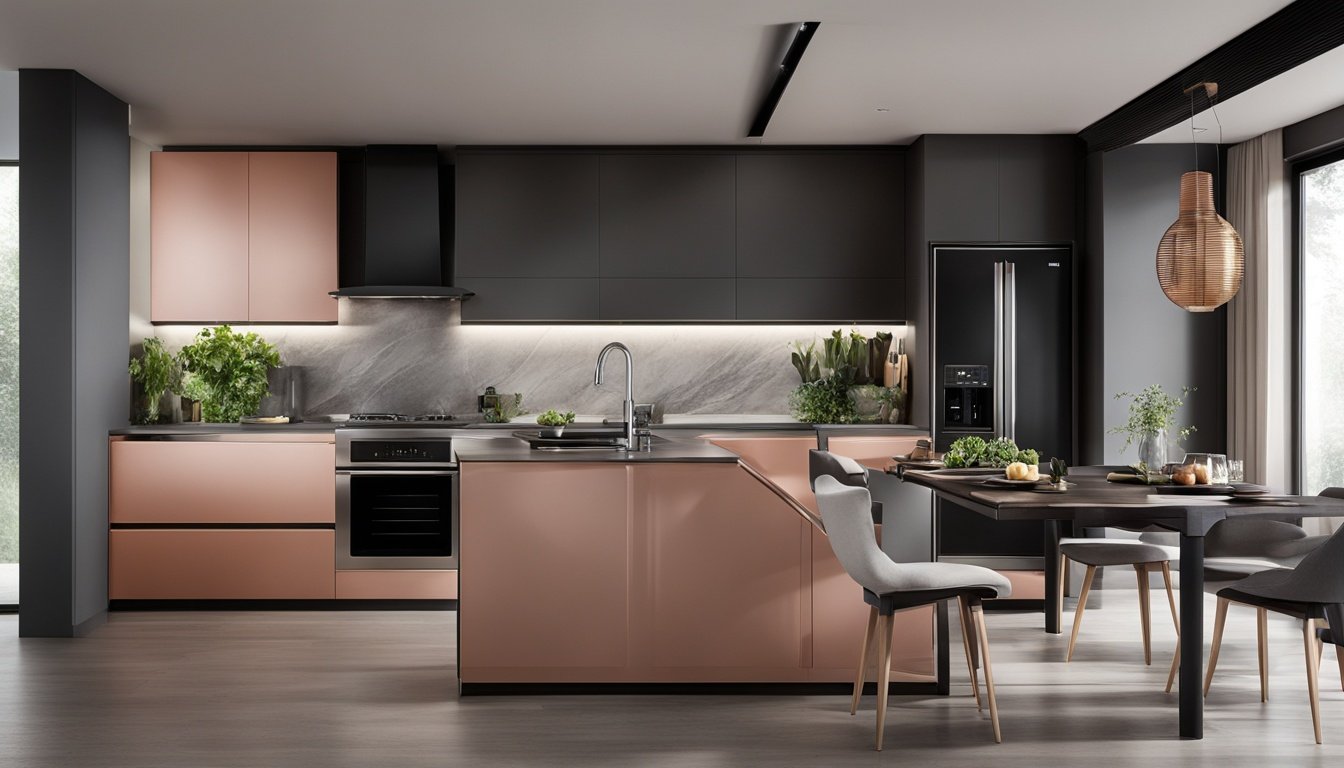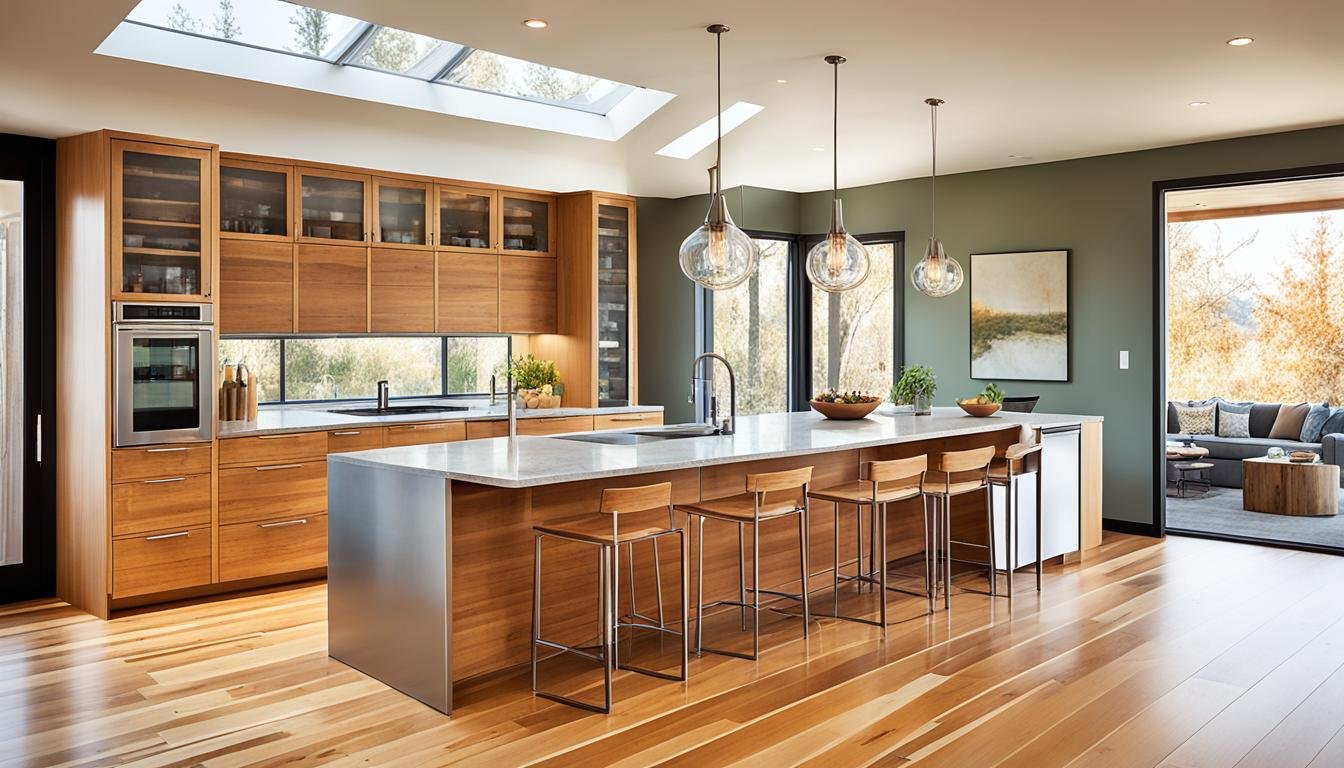Making your home both beautiful and eco-friendly is key to sustainable interior design. By using green practices, you can make a space that shows off your style and helps the planet. This guide will show you how to make your home more sustainable and eco-friendly.
Key Takeaways:
- 1. Sustainable home design combines style and environmental responsibility.
- 2. Embracing sustainable practices in your interior design reduces your carbon footprint.
- 3. Focus on using energy-efficient lighting to save energy and reduce costs.
- 4. Opt for energy-efficient appliances to minimize electricity consumption.
- 5. Choose sustainable materials such as bamboo, reclaimed wood, and recycled metals.
What is Sustainable Interior Design?
Sustainable interior design makes spaces look good and helps the planet. It uses practices and materials that save energy and lessen harm to the earth. By using sustainable design, you make a healthier home for now and the future.
Energy efficiency is a big part of sustainable design. It means using lights and appliances that use less power. LED lights and efficient appliances cut down on energy use and carbon emissions.
Eco-friendly materials are also key. They come from sustainable sources and can be recycled. Using these materials saves natural resources and makes the air cleaner by having fewer toxins.
Water conservation and air quality are also important. Using less water and good ventilation systems helps save water and makes the air better inside your home.
Sustainable interior design combines many elements for a space that looks good and cares for the earth. By choosing sustainable design, you help the planet and enjoy a cozy, stylish home.
| Benefits of Sustainable Interior Design |
|---|
| 1. Reduced energy consumption and lower utility bills |
| 2. Improved indoor air quality and better health |
| 3. Preservation of natural resources |
| 4. Contribution to a cleaner environment |
| 5. Positive impact on future generations |
Save Energy with Lighting
Making your home eco-friendly is easy with energy-efficient lighting. Choosing the right lighting can cut down your energy use and lessen your environmental impact.
LED bulbs are a great choice for saving energy. They use 75% less energy than old incandescent bulbs. This makes them good for the planet and your wallet. Plus, they last longer, which means you replace them less often and create less waste.
It’s not just about the bulbs. Using natural light in your home can also save energy. By placing windows and skylights right, you can use daylight more. This cuts down on artificial lighting during the day. It also makes your home brighter and more welcoming.
Here are some tips for getting more natural light in your home:
- Position furniture and decor to let light move easily through the space.
- Use light-colored paint and finishes to reflect natural light and brighten the room.
- Choose sheer curtains or blinds for natural light while keeping your privacy.
- Think about adding skylights or light tubes for more natural light.
Using LED bulbs and natural light can greatly reduce your energy use. This makes your home more sustainable and energy-efficient. So, pay attention to your lighting choices and embrace energy-efficient lighting!
Use Energy-Efficient Appliances
Choosing energy-efficient appliances for your home is a wise and green choice. These appliances cut down on energy use and save you money on bills. Always check for the Energy Star rating when buying new appliances. This label means they meet tough energy-saving standards set by the EPA.
Appliances with the Energy Star rating work well and use less energy. This means they’re good for the planet and can help fight climate change. By picking these appliances, you’re doing your part for a greener future.
Benefits of Energy-Efficient Appliances:
- Energy Savings: These appliances use new tech to use less energy. This cuts down your carbon footprint.
- Cost Savings: They’re made to use less energy without losing performance. This means lower bills for you.
- Longevity: They’re built to last. Their quality and features mean they don’t need to be replaced often, which helps reduce waste.
- Environmental Impact: Using less energy means less pollution and less strain on natural resources. This makes the planet healthier and more sustainable.
Make your home greener by getting energy-efficient appliances. Start by swapping old appliances for Energy Star-rated ones like fridges, washing machines, dishwashers, and air conditioners. You’ll help the planet and enjoy the latest tech and save on energy costs.

Sustainable Materials for Interior Design
Choosing sustainable materials for your interior design helps the environment. Opting for materials that are renewable, repurposed, or eco-friendly makes your space stylish and green. This supports sustainability.
Bamboo
Bamboo is a top choice for flooring, furniture, and textiles. It grows fast and can be harvested without harming the planet. Bamboo brings a natural warmth and beauty to any room.
Cork
Cork is a sustainable option for flooring, wall coverings, and furniture. It comes from the bark of cork oak trees, which can be harvested without cutting down the tree. Cork is eco-friendly and great for sound insulation and cushioning.
Reclaimed Wood
Reclaimed wood is great for reducing waste in interior design. It comes from old buildings, barns, or discarded furniture. Using reclaimed wood adds character and history to your space, and it helps save trees.
Recycled Glass
Recycled glass is both beautiful and eco-friendly for countertops and decor. It reduces the need for new glass, cuts down on waste, and saves resources. Adding recycled glass to your design looks elegant and supports a circular economy.
When picking sustainable materials, look for brands that focus on ethical sourcing and production. Choosing sustainable materials for your design makes your space beautiful and reflects your eco-friendly values.

Water Conservation
Conserving water is key to eco-friendly living. It protects our planet’s resources and lowers our water bills. By using simple strategies, you can make a big difference at home.
Low-Flow Fixtures
Installing low-flow fixtures is a big step in saving water. These include showerheads, toilets, and faucets that use less water without losing functionality.
“Replacing traditional showerheads with low-flow versions can save up to 2,700 gallons of water per year!” – Green Living Experts
Low-flow showerheads let you enjoy your showers while using less water. Low-flow toilets also use less water per flush. Adding these to your home makes saving water easy.
Rainwater Collection
Reducing water usage isn’t just about indoor changes. Consider using rainwater collection systems. This practice collects and reuses rainwater for household needs.
Using rainwater helps with gardening, toilet flushing, and car washing. It lessens the load on city water and uses a free resource.
Plan your rainwater system with proper filters and storage for clean water. A rain barrel or cistern is a good way to store it safely.
Using low-flow fixtures and rainwater systems can greatly help with water conservation. These changes lead to big water savings and a greener future.
The Benefits of Water Conservation
- Reduces water usage and lowers water bills
- Preserves natural resources and protects ecosystems
- Lessens strain on water treatment and distribution systems
- Contributes to a more sustainable and eco-friendly lifestyle
By saving water, you’re helping your home and setting a good example. Together, we can make a greener, more sustainable future through water conservation.
Purify the Air with Indoor Plants
Indoor plants are more than just pretty decorations. They are key to making the air in your home cleaner. These plants filter out pollutants and add oxygen, making the air fresher. Adding greenery to your home can make it healthier for you and your family.
Indoor plants clean the air by taking in carbon dioxide and giving out oxygen. They also remove toxins like formaldehyde, benzene, and xylene from household items. These items include cleaning products, furniture, and carpets.
Some plants are better at cleaning the air than others. The snake plant, also called mother-in-law’s tongue, is great for removing toxins at night. It’s a top pick for improving air quality while you sleep.
Spider plants are another good choice for cleaning the air. They take out formaldehyde, xylene, and carbon monoxide. These plants are perfect for homes near busy streets or with smokers.
Succulents, like aloe vera, are not only pretty but also clean the air. They remove formaldehyde and benzene. These plants need little care and do well in bright, indirect light, making them great for busy people.
Peace lilies are known for their beautiful white flowers and air-cleaning abilities. They remove formaldehyde, benzene, and trichloroethylene from the air. These plants are easy to care for and can live in low light.
Adding indoor plants to your home does more than just make it look better. It also makes it healthier. The greenery creates a calming and peaceful atmosphere.
Choosing plants like snake plants, spider plants, succulents, or peace lilies will make your home fresher and healthier. These plants help purify the air, making your living space more enjoyable.
Conclusion
Creating a sustainable home design helps the environment and improves your health. Use energy-efficient lights and appliances to cut down on energy use and reduce your carbon footprint. Choosing sustainable materials for your home adds style and makes your furniture last longer.
Using less water and adding indoor plants also boosts your eco-friendly lifestyle. These small steps lead to a healthier and greener home. By doing this, you help make a better future for everyone.


